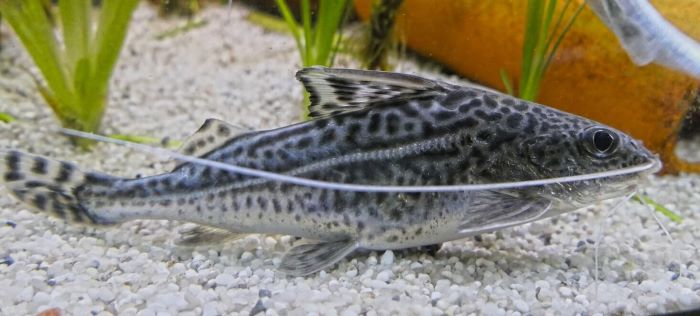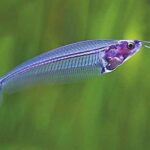Pictus Catfish Size and care, Pictus catfish are a suitable addition to many community freshwater tanks. Their nocturnal nature requires dim lighting or daytime hiding places. These fish have the ability to grow up to a yard long, but most Pictus catfish reared in captivity do not end up with that size.
- Common Name: Pictus catfish, Pictus cat.
- Scientific name: Pimelodus pictus.
- Adult Size: 5 to 6 inches tall.
- Life expectancy: 4 to 8 years.
Pictus catfish is a nocturnal fish native to South America. They are found in the basins of the Amazon and Orinoco rivers but have been kept in aquariums for several generations.
Pictus catfish has a smooth silver body with black spots. Like other catfish species, they do not have any external scales. They have common thorns, used to scoop food deep into the substrate, and sharp spines on the pectoral and dorsal fin.
Take care when handling these fish to avoid pricking the spines. These fish are often stuck in nets, so an open container is recommended for handling these fish.
If your hand is pierced by a catfish spine, clean it carefully and do not return your hand to the tank water. Fish healer disease can occur if these wounds are not treated carefully.
If you have any family members with weak immune systems, including young children and the elderly, there is also a risk of fungi spp. Infection, known as “fish tuberculosis”, is associated with fish-related infections.
Being a calm and nocturnal fish, Pictus catfish can be kept with many different species, provided they are not very aggressive during the day while Pictus catfish are hiding. You can keep more than one Pictus catfish in a tank, just keep in mind the large tank size requirements.
When choosing suitable tank mates for peaceful community aquariums, make sure of their water quality parameters, specifically pH, kH, and temperature, everyone agrees.
The most important part of the Pictus catfish habitat is its quiet place to rest during the day. Don’t expect to see Pictus catfish much during the day unless you use dim and mute lighting on your tank.
During the day, make sure you have a cave or log of Pictus catfish to hide in. If you have Pictus catfish, nocturnal species, or bottom feeders, such as Plecostomous spp. Make sure you have enough hiding places for everyone.
Pictus catfish is a carnivore and will easily adapt to a grain diet. Since they are nocturnal fish, be sure to leave some food for them when the tank lighting is off.
In dimly lit tanks, you may see your fish go out to eat with the rest of the tank’s inhabitants. You are welcome to supplement your Pictus catfish with both meat and vegetables.
Don’t expect these species to be cleaned up after the other fish. Although they are bottom-feeding and most likely eating some hangovers, they are not their primary diet and will often require separate feeding due to their nocturnal nature.
In the wild, you’ll find that Pictus Catfish are scavengers and will eat pretty much anything they can find. They are carnivores by nature, so they eat meat and plant matter.
In the warm waters of South America, they will be found eating insects (dragonfly larvae), snails, small fish, and algae.
This makes keeping and feeding catfish extremely easy. They’ll pretty much wear out everything you put in the tub.
As always, the core of your catfish diet should be high-quality pellets. You’ll remember in the behavior section that we said that catfish spend long periods of their time in hidden areas near the bottom of the tank. For this reason, be sure to use soaked pellets. To provide them with some variety, you can always use food such as:
- Fresh foods (brine shrimp and heart-shaped beef).
- Frozen foods (bloodworms and black worms).
- Vegetables.
They will also spend periods of time searching for food in the substrate of your aquarium, so you can let any algae grow because your Pictus will eat them.
As a general rule, they will ignore most of the live foods that live at the top of the dwelling because they don’t want to get away from the bottom of the tank.
Finally, it must be repeated that they have a great appetite. You must make sure to keep it full to prevent the aggressive behavior of small fish in the tank. Additionally, since it produces a lot of waste, you must ensure that water changes are made at least every two weeks (25%).
Unfortunately, the Pictus catfish does not have any external sexual characteristics. With individuals of the same age and care, females may be larger than males.
Breeding the Pictus catfish is not easy. Many advanced amateurs struggle to provide a suitable habitat for these fish to lay their eggs. A very large aquarium is recommended and using a group of fish will definitely increase your chances. Always ensure that all new breeding fish are properly isolated, especially if they come from different sources.
As with any indoor aquarium, it is recommended to provide a breeding or spawning tank separate from the home tank in order to manipulate the chemistry of the water and provide a safe environment for any offspring.






